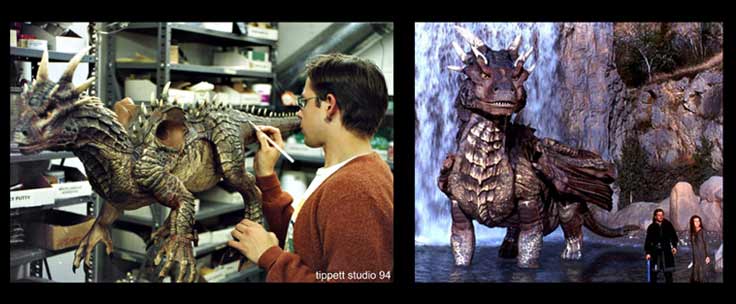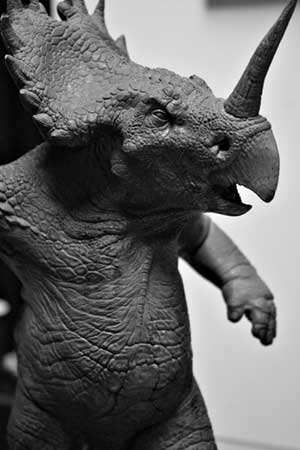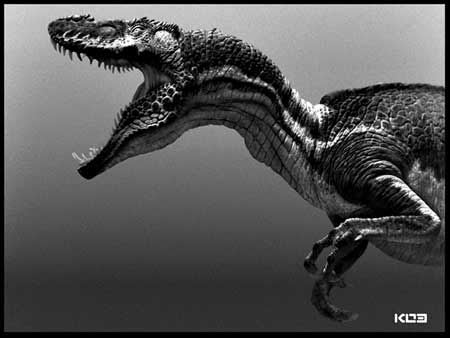

3D Modeler
Special thanks to Peter Konig for taking time out of his busy schedule working at Tippett Studio to talk to us about how he got his break in Modeling and Animation. You can also see more of Peter's work at Massive Black.
Peter Konig
// Animator/Modeler/Sculpter
Tell us about yourself Peter; where are you from and how old were you when you discovered that you wanted to be a Modeler?
I was born in Hollywood California, but I mostly grew up in the San Francisco Bay Area. I guess I was pretty young, maybe 4 or 5 when I first got the bug to make monsters, but of course it wasn't until many years later that I was able to decide to do it for a living. By "modeler" I suspect you mean sculptor, because that was my first aim, to sculpt in clay to create creatures and characters.

I'm pretty sure my attempts go back to preschool days. But I was obsessed with Godzilla and was constantly trying to make that character. It wasn't until my teen years though that I really focused on sculpture. I wasn't totally sure where it would take me, or how I was going to get into the movie business, but I knew that I loved to do it.
Are you formally trained or are you self-taught?
Self taught for the most part, but I was always looking for information in movie magazines and whatever books existed on the subject, which weren't many. Most of my "training" came from books on anatomy, animals and nature and books about other artists. It wasn't easy having the strange interests that I did where I grew up. I certainly didn't know anyone else who wanted to do what I wanted to, and there weren't any galleries or museums anywhere nearby where I could see real art in person.
Do you think that artists with a formal education in animation or Modeling have an advantage over self-taught artists?
You know, I think it all comes down to the person. I suppose I could have benefited from formal art school training, but in the end I think I was driven enough to find my own way. For animation, it's hard to say. I review a large number of animator demos and I have to say that school or no school, most of the tapes are pretty lousy. One out of a hundred is decent, no joke. I tend to think that you're either born with the talent or you're not. People with minimal talent can be coached into being somewhat competent, but they can't hold a candle to folks that just have it in their blood. I can only say that because I've been doing this stuff long enough and have seen enough of it first hand, though of course you'll come across exceptions. But until you try and work hard at it, you just don't know if you got "it" or not.
How hard is it for a self-taught artist to break into the special effects business?
I think that the only thing a self taught artist is really missing is the whole network thing. All the friends from school that can tip you off to find work and that kinda thing. Connections are fairly important and if you go to school you can come out with more that if you hadn't. But when I interview someone for sculpting or animation, all I care about is the quality of the work. If they are sane, hardworking people with a great demo, that's really all I care about. I don't even look at the resume or credentials until I've seen the demo tape or dvd. If it isn't any good, I don't really care where they went to school.
How important is knowing how to draw when it comes to Sculpting and Animating?
I just think that the more creative skills you posses, the better off you are. Each skill feeds from and contributes to the other.
What was your first job in the movie industry and how old were you when you were hired?
My first professional job was for a very low budget horror movie for James Hong, who was the actor who played the eyeball engineer in Bladerunner. He and a couple or other people wanted to make a few bucks, so they did a zombie movie called The Vineyard. I was hired as the special effects makeup guy along with a buddy of mine. I was only 20 at the time and didn't know what I was in for, but after all the suffering and toil and pain, I did learn quite a lot. But man, was it a painful process.
You are both an Animator and a Sculptor which do you find more rewarding?
My favorite area of work is definitely in the design and sculpture area. Animation is really great in it's own way, but if forced to choose, I'd go the more analog route. Though I'm starting to get into 3d modeling and that's a ton of fun as well.

Boy, that's a tricky one. If it's for myself, I'll often just have a glimmer in my mind of what it should come out like and I'll just start. If it's for work, I'll usually have a sketch or design to go from, either from myself or from production. But talking about the creative process is hard. I'm usually trying to capture a mood or an emotion or a personality in what I'm doing. That's the trickiest part, knowing in your mind where something needs to be and transposing that out of your brain, down your arm and out through your fingers. The mechanical part of sculpting is much easier than keep the right internal dialogue going and keeping all the notes in mind as you work, trying to make sure that you're producing exactly what you or your client wants. Phil Tippett calls it "the persistence of vision". Mainly it takes practice and a lot of trial and error. You can't be afraid to screw up. In the beginning, all you'll do is screw up. But that's part of evolving. Even when you're a pro you'll find yourself destroying things and reworking and reworking. It's all part of the process. Sorry if I strayed a bit here.
What supplies do you use to create your Models?
I work in one of three mediums usually. Chavant oil based clays, water based clays, such as WED clay, and Super Sculpey. For the understructure of a sculpt I usually use aluminum wire. For tools I use many that are just off the shelf, such as Kemper tools, but I also make many of my own.
You've created characters for major motion pictures could you give us a list of your credits?
I've worked on a number of different films in a variety of roles. I've designed, sculpted and fabricated and art directed on films such as: Bill and Ted's Bogus journey, Radio Flyer, Of Mice and Men, Honey, I Blew up the Kid, Jurassic Park, Coneheads, Starship Troopers, Dragonheart, Evolution, The League of Extraordinary Gentlemen, and Starship Troopers II to name a few. I've also animated and animation supervised on several films including: Tremors II, Starship Troopers I and II, The Haunting, Cat's and Dogs, Blade II, The Stepford Wives, and currently Mask II.
How much contact do you have with the movie directors of the projects you work on?
Depends on the position I have on the project and the director him/herself. On Starship Troopers, Paul Verhoeven was extremely involved and would come to the studio often, or we'd go to him. On Evolution, we dealt with Ivan Reitman on a weekly basis during the preproduction phase. All the design work came down to him and what he liked and he seemed to enjoy developing the characters with us. While working on the Stepford Wives, we video conferenced several days a week with Frank Oz on the east coast. Having direct contact with a director is always beneficial because otherwise you are hearing requests second and third hand.
Can you take us through a typical workday at Tippett Studio?
Well, I usually stumble in around 10 minutes late on average. I get my coffee. Delete 300 pieces of junkmail. Then I check my daily from the night before. Everyday we have dailies where you render your animation or whatever you are working on and there is a morning review session with most of the crew. The visual effects supervisor and other department leads watch the shots projected big, like in a movie theater, and they give their comments, request changes etc. We also have "cut-ins" where our individual shots are cut into the sequence of the film on the Avid. There we can see how the sequence flows and how our work cuts together with the rest of the footage or with coworkers shots. Once we get our notes, we spend the rest of the day making the changes. Often times people stay fairly late to get the work done. Schedules being what they are these days, there is usually more work than there is time. Overtime is a way of life at most companies. It's certainly a job that requires a great deal of focus and time.

I particularly love getting to do design work. Anything creative, from 2d concepting to maquette sculpting. And with animation, I really love a challenging shot, one that requires skill and finesse and a certain amount of ingenuity. My favorite animations are the ones that require you to really "act" through the puppet. Showing personality and character through a computer generated puppet is difficult to pull off, but when done well is extremely rewarding. My least favorite work is anything monotonous and repetitive. I like the feeling I get when sense that I'm expanding my skills. Anytime I feel like I'm spinning my wheels and moving sideways instead of forward is not particularly enjoyable.
Could you tell us about your most recent project?
The last project I worked on was The Stepford Wives. I was animation supervising along with Tom Schelesny. It was a fairly challenging project mainly because of the mixing of the effects with live actors and making it all read as believable. There were many scenes involving cg body doubles and that was tricky as well. Duplicating a well known actor on screen is probably one of the most difficult feats to achieve, but I think we did a fantastic job in the end. But overall it was a very demanding show, many many hours, many long days trying to get all the elements together looking right. Unfortunately, several major shots ended up on the cutting room floor due to last minute editing decisions. We knew that they made the changes they thought would improve the picture, but it was still frustrating and sad to see so much hard work get tossed. But who knows, we might see the stuff on the DVD at some point.
You've started a company with a group of concept artist and designers called Massive Black. What kind of work does Massive Black focus on?
We're expecting to be a highly regarded and sought after outsourcing company, focusing mainly on concept design for games and film as well as providing actual assets such as modeling and texturing to projects that either lack a high-end art staff, or would just prefer the kind of high quality we're offering. We have a sort of "dream team" of designers, some of the best in the industry from a wide variety of specialties. As game graphics are steadily evolving to the level of movie quality, we've assembled a group of uniquely talented and experienced artists to meet the needs of evermore sophisticated games. We can see that the line between movies and games is likely to continue to blur as technology improves, so our group is particularly well suited to work in that environment.

Produce a strong portfolio. Be ruthless and harsh when judging what you think is fit to show. Show only your absolute best work. Keep the presentation simple and to the point. If you're good, you'll find work, but realize that the competition is very stiff, especially in the effects business. I would strongly recommend getting a good 3d modeling background in addition to the traditional stuff. You gotta eat, and regular clay sculpting jobs are harder and harder to find. If you love shapes, 3d modeling can be a natural extension, and make you more versatile as far as job hunting goes. But I'm not about to tell someone with a passion to put it aside and learn computers instead. Just expect that things can get tough sometimes, be realistic.
What advise would you give to the guy or gal who reads this interview and thinks what you do is pretty cool; how do they get started?
Learn the craft that interests you. Just do it for the love of it first. Don't chase skills down in order to make a certain salary or because you heard it was a cool job to have. Do it because you love it, work hard to become fantastic at it. If you stand out, if you're tough and resourceful and persistent, you'll have a great chance to do it for a living. Don't be frustrated while paying your dues. Most people I know had to do it. Get a strong background in the basics, and move on from there. There are no real shortcuts. Other than that, make friends in the area you're interested in. Go to sites like Conceptart.org, or go to figure drawing classes. You are far more likely to get a job through a friend than any other way I know. Do I sound enough like a dad or what? Stop reading this and get back to work!
Thanks to Peter Konig ) for agreeing to answer the questions I had for him.




